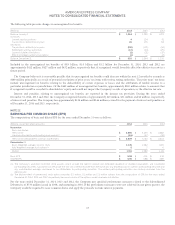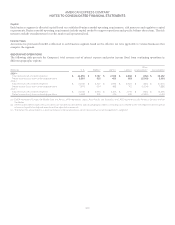American Express 2014 Annual Report Download - page 116
Download and view the complete annual report
Please find page 116 of the 2014 American Express annual report below. You can navigate through the pages in the report by either clicking on the pages listed below, or by using the keyword search tool below to find specific information within the annual report.
AMERICAN EXPRESS COMPANY
NOTES TO CONSOLIDATED FINANCIAL STATEMENTS
NOTE 23
REGULATORY MATTERS AND CAPITAL ADEQUACY
The Company is supervised and regulated by the Federal Reserve and is subject to the Federal Reserve’s requirements for risk-based capital
and leverage ratios. The Company’s two U.S. bank operating subsidiaries, American Express Centurion Bank (Centurion Bank) and
American Express Bank, FSB (FSB) (together, the Banks), are subject to supervision and regulation, including similar regulatory capital
requirements by the Federal Deposit Insurance Corporation (FDIC) and the Office of the Comptroller of the Currency (OCC), respectively.
Under the risk-based capital guidelines of the Federal Reserve, the Company is required to maintain minimum ratios of Common Equity
Tier 1 (CET1), Tier 1 and Total (Tier 1 plus Tier 2) capital to risk-weighted assets, as well as a minimum leverage ratio (Tier 1 capital to
average adjusted on-balance sheet assets).
Failure to meet minimum capital requirements can initiate certain mandatory, and possibly additional, discretionary actions by
regulators, that, if undertaken, could have a direct material effect on the Company’s and the Banks’ operating activities.
As of December 31, 2014 and 2013, the Company and its Banks met all capital requirements to which each was subject and maintained
regulatory capital ratios in excess of those required to qualify as well capitalized.
The following table presents the regulatory capital ratios for the Company and the Banks:
(Millions, except percentages)
CET1
capital(b)
Tier 1
capital
Total
capital
CET1
capital ratio(b)
Tier 1
capital ratio
Total
capital ratio
Tier 1
leverage ratio
December 31, 2014:(a)
American Express Company $ 17,525 $ 18,176 $ 20,801 13.1 % 13.6% 15.6% 11.8 %
American Express Centurion Bank 6,174 6,174 6,584 18.8 18.8 20.1 18.7
American Express Bank, FSB 6,722 6,722 7,604 14.2 14.2 16.0 15.1(c)
December 31, 2013:
American Express Company (b) $ 16,174 $ 18,585 (b) 12.5% 14.4% 10.9 %
American Express Centurion Bank (b) 6,366 6,765 (b) 19.9 21.2 19.0
American Express Bank, FSB (b) 6,744 7,662 (b) 15.6 17.7 17.5(c)
Well-capitalized ratios(e) (f) 6.0% 10.0% 5.0 %(d)
Minimum capital ratios(e) 4.0 % 5.5% 8.0% 4.0 %
(a) Beginning in 2014, as a Basel III Advanced Approaches institution, capital ratios are reported using Basel III capital definitions, inclusive of transition provisions
and Basel I risk-weighted assets.
(b) As part of the new Basel III capital rule, effective for 2014, Basel III Advanced Approaches institutions are required to disclose Common Equity Tier 1 capital and
associated ratio.
(c) FSB Tier 1 leverage ratio is calculated using ending total assets in 2013 and average total assets in 2014 as prescribed by OCC regulations applicable to federal
savings banks.
(d) Represents requirements for banking subsidiaries to be considered “well-capitalized” pursuant to regulations issued under the Federal Deposit Insurance
Corporation Improvement Act. There is no “well-capitalized” definition for the Tier 1 leverage ratio for a bank holding company.
(e) As defined by the regulations issued by the Federal Reserve, OCC and FDIC for the year ended December 31, 2014.
(f) Beginning January 1, 2015, Basel III CET1 well-capitalized ratios become relevant capital measures under the prompt and corrective action requirements defined
by the regulations for Advanced Approaches institutions.
116
























